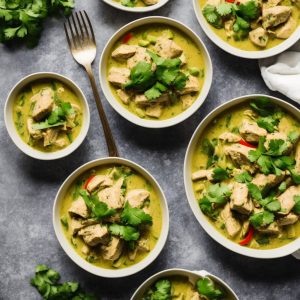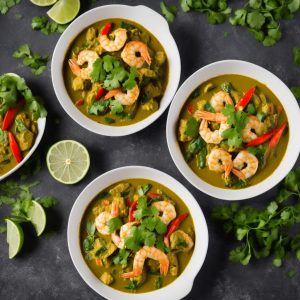This enticing vegetarian Thai green curry recipe brings the authentic flavors of Thai cuisine into your kitchen. It combines fresh veggies, tofu, and a rich, spicy coconut curry sauce, all served over fluffy brown basmati rice. This aromatic and vibrant dish is easy to prepare and perfect for those seeking a hearty vegetarian meal with a kick.

The key ingredient you may need to look for at the supermarket is Thai green curry paste. It's a blend of green chilies, lemongrass, garlic, and other spices, essential for that authentic Thai flavor. Also, look for light coconut milk, which offers a rich, creamy base for the curry without the high-fat content. Lastly, turbinado raw sugar, also known as 'raw sugar,' lends a subtle, molasses-like sweetness to the dish.
Ingredients for Vegetarian Thai Green Curry
Brown basmati rice: A whole grain rice variety, it's perfect for absorbing all the flavors of the curry.
Olive oil: Used for sautéing the veggies and tofu, and for its mild flavor.
White onion: Adds a sweet and mild flavor to the curry.
Ginger: Provides a spicy, aromatic kick.
Garlic: Lends a pungent, warming flavor.
Salt: For seasoning and enhancing other flavors.
Thai green curry paste: The heart of the curry, providing all the quintessential Thai flavors.
Thai chiles: Adds heat and spice to the curry.
Light coconut milk: Gives the curry its creamy texture and subtle sweetness.
Turbinado raw sugar: Adds a touch of sweetness to balance the spices.
Tofu: The protein of the dish, tofu soaks up all the flavors wonderfully.
Brown rice wine vinegar: Adds a bit of acidity to balance the rich curry.
Soy sauce: Infuses the curry with a deep, savory flavor.
Cilantro: For both flavor and garnish. Its bright, fresh taste complements the spicy curry.
Seasonal vegetables: Add color, texture, and extra nutrition to the dish.
One reader, Gui Landrum says:





This vegetarian Thai green curry recipe is a game-changer! The flavors are so vibrant and the combination of tofu and seasonal veggies is simply divine. The curry paste adds the perfect amount of heat, and the coconut milk makes it so creamy. It's a must-try for anyone looking for a delicious and satisfying meatless meal.
Key Techniques for Mastering Vegetarian Thai Green Curry
How to cook the rice: Rinse the rice in a mesh colander and then cook it in a rice cooker with 2 ½ cups of water or according to your manufacturer’s instructions.
How to prepare the tofu: Drain the tofu and gently squeeze it to release some of the water. Slice it in half into two square slabs, then cut it into bite-sized strips.
How to sweat the onion, ginger, and garlic: Heat a 10-inch skillet with deep sides over medium-low heat. Once hot, add a drizzle of oil and sweat the onion, ginger, and garlic with a sprinkle of salt for about 7 minutes.
How to steam the vegetables: Steam the vegetables until tender using your preferred method.
How to serve: Serve the rice, curry, and vegetables onto each plate and garnish with extra cilantro if desired.
How To Make Vegetarian Thai Green Curry
This Thai green curry recipe is the perfect meal for vegetarians made with fresh veggies and flavorful spices served with steamed seasonal greens.
Serves:
Ingredients
- 1¼cupbrown basmati rice
- 2½cupswater
- 1tbspolive oilor quality vegetable oil
- 1white onionsmall, diced
- 1inchnub of gingerfinely chopped
- 2garlic clovesfinely chopped
- salt
- 2tbspThai green curry paste
- 3Thai chileschopped, optional
- 1canlight coconut milk
- ½cupwater
- 2tspturbinado raw sugaror brown sugar
- 1pkgtofuextra-firm, optional
- 2tspbrown rice wine vinegar
- 2tspsoy sauce
- cilantrochopped
- 2cupsseasonal vegetableschopped, like broccoli, asparagus, carrots or bell peppers
Instructions
-
Cook the rice. Rinse the rice in a mesh colander and then cook it in a rice cooker with 2 ½ cups water or according to your manufacturer’s instructions.
-
Give the rice some time to cook as you prepare all the vegetables. Drain the tofu and squeeze it gently to release some of the water. Slice it in half, into two square slabs, and slice it into bite-sized strips.
-
Heat a 10-inch skillet with deep sides over medium-low heat. Once it’s hot, add a drizzle of oil. Sweat the onion, ginger, and garlic with a sprinkle of salt for about 7 minutes.
-
Raise the heat to medium and add the curry paste and chilies, stirring often for a couple of minutes.
-
Shake or stir the coconut milk and then pour it into the pan. Add the water, sugar, and chopped tofu then cook until the tofu is warmed through and the liquid has reduced to your desired consistency.
-
Remove from heat and season with rice wine vinegar and soy sauce, to taste.
-
Steam the vegetables until tender using your preferred method. Stir cilantro into the curry.
-
Serve rice, curry, and vegetables onto each plate and garnish with extra cilantro, if desired.
Nutrition
- Calories: 459.31kcal
- Fat: 16.16g
- Saturated Fat: 6.78g
- Monounsaturated Fat: 4.33g
- Polyunsaturated Fat: 2.76g
- Carbohydrates: 64.14g
- Fiber: 6.24g
- Sugar: 7.54g
- Protein: 14.63g
- Cholesterol: 0.74mg
- Sodium: 1285.14mg
- Calcium: 221.97mg
- Potassium: 596.87mg
- Iron: 3.58mg
- Vitamin A: 156.84µg
- Vitamin C: 58.94mg
Crucial Technique for Perfecting Thai Green Curry
When preparing the tofu for this vegetarian thai green curry, it's important to press it properly to remove excess water. This will allow the tofu to absorb more of the curry flavor. To do this, wrap the tofu in a clean kitchen towel or paper towels, place it on a flat surface, and put a heavy object on top, such as a cast iron skillet or a cutting board with some heavy cans on top. Let it sit for at least 15 minutes before cutting it into strips. This will result in a more flavorful and satisfying dish.
Time-Saving Tips for Making Thai Green Curry
Prep ahead: Chop vegetables and tofu in advance to save time during the cooking process.
One-pot cooking: Consider using a larger pot to cook the curry and rice together, saving time and reducing clean-up.
Quick-cooking vegetables: Choose vegetables that cook quickly to minimize the time needed for steaming.
Efficient multitasking: While the rice is cooking, prepare the curry ingredients to make the most of your time in the kitchen.
Use store-bought curry paste: Opt for pre-made Thai green curry paste to cut down on prep time without sacrificing flavor.
Batch cooking: Make a larger portion of the curry and rice to have leftovers for future quick and easy meals.
Streamline ingredient prep: Minimize the number of ingredients or opt for pre-cut vegetables to reduce prep time.
Tofu preparation: Consider using pre-pressed tofu to skip the step of draining and pressing the tofu before cooking.
Efficient clean-up: Wash and clean as you go to minimize the time spent on post-cooking clean-up.
Substitute Ingredients For Vegetarian Thai Green Curry Recipe
brown basmati rice - Substitute with quinoa: Quinoa is a high-protein grain that can be used as a nutritious alternative to rice in this recipe.
olive oil - Substitute with coconut oil: Coconut oil adds a subtle tropical flavor that complements the Thai green curry paste and coconut milk.
tofu - Substitute with tempeh: Tempeh has a firmer texture and nuttier flavor, which works well in absorbing the flavors of the curry.
light coconut milk - Substitute with coconut cream: Coconut cream will add a richer and creamier texture to the curry, enhancing its overall flavor.
brown rice wine vinegar - Substitute with apple cider vinegar: Apple cider vinegar provides a slightly fruity and tangy flavor that complements the other ingredients in the curry.
seasonal vegetables - Substitute with bell peppers, snap peas, and bamboo shoots: This combination of vegetables adds color, texture, and a variety of flavors to the curry.
Presentation Tips for a Stunning Vegetarian Thai Green Curry
Elevate the rice: Mold the brown basmati rice into a perfect round shape using a small bowl to create a visually appealing base for the curry.
Artful arrangement of tofu: Arrange the tofu strips in a delicate, crisscross pattern on top of the rice to add a touch of elegance to the dish.
Vibrant vegetable medley: Create a colorful and visually appealing vegetable medley by arranging the seasonal vegetables in a circular pattern around the curry, using a variety of shapes and colors to add visual interest.
Garnish with fresh cilantro: Sprinkle freshly chopped cilantro over the curry and around the plate to add a pop of vibrant green color and a burst of fresh flavor.
Drizzle with coconut milk: Use a small spoon to delicately drizzle a small amount of coconut milk around the edge of the plate, creating an artistic and professional finishing touch.
Use fine dining plating techniques: Employ fine dining plating techniques such as negative space and precise placement to create a visually stunning and sophisticated presentation.
Essential Kitchen Tools for Making Thai Green Curry
- Rice cooker: A kitchen appliance used to cook rice automatically, ensuring perfectly cooked rice every time.
- Mesh colander: A bowl-shaped kitchen tool with small holes, used to drain liquids from food, such as rinsing rice or draining pasta.
- Skillet with deep sides: A type of frying pan with high sides, suitable for cooking dishes with liquids or sauces.
- Cutting board: A flat board used for cutting and preparing ingredients, such as chopping vegetables or slicing tofu.
- Chef's knife: A versatile kitchen knife used for a variety of tasks, such as chopping, slicing, and dicing ingredients.
- Steamer: A kitchen tool used to cook food with steam, such as steaming vegetables to retain their nutrients and flavors.
- Rice paddle: A utensil designed for stirring and serving rice, ensuring gentle handling to maintain the rice's texture.
- Saucepan: A deep cooking pan with a handle and a lid, suitable for making sauces or heating liquids.
Storing and Freezing Vegetarian Thai Green Curry
- Allow the vegetarian thai green curry to cool completely before storing or freezing.
- For short-term storage, transfer the curry to an airtight container and refrigerate for up to 3-4 days.
- When ready to reheat, warm the curry in a saucepan over medium heat, stirring occasionally, until heated through. You may need to add a splash of water or coconut milk to thin the consistency if it has thickened during storage.
- For longer storage, freeze the curry in freezer-safe containers or resealable bags for up to 3 months.
- To freeze, portion the cooled curry into individual serving sizes or a large batch, depending on your preference. Leave some headspace in the containers or bags to allow for expansion during freezing.
- Label the containers or bags with the date and contents for easy identification.
- To reheat frozen curry, transfer it to the refrigerator to thaw overnight. Once thawed, reheat the curry in a saucepan over medium heat, stirring occasionally, until heated through. You may need to add a little water or coconut milk to adjust the consistency.
- If you plan to freeze the curry, it's best to undercook the vegetables slightly to prevent them from becoming mushy when reheated.
- Store the cooked rice separately from the curry, as it tends to absorb liquid and become soggy over time. Reheat the rice separately in the microwave or by steaming it until heated through.
How To Reheat Leftover Thai Green Curry
Stovetop method: transfer the leftover vegetarian thai green curry to a saucepan or skillet. Heat it over medium-low heat, stirring occasionally, until it's warmed through. If the curry seems too thick, add a splash of coconut milk or water to thin it out. This method allows you to control the temperature and consistency of the curry, ensuring it doesn't burn or become too watery.
Microwave method: place the leftover curry in a microwave-safe bowl. Cover the bowl with a damp paper towel or a microwave-safe lid to prevent splatters. Microwave on high for 1-2 minutes, stirring every 30 seconds, until the curry is heated through. Be careful when removing the bowl from the microwave, as it may be hot. While this method is quick and convenient, it may cause the tofu and vegetables to become slightly soggy.
Oven method: preheat your oven to 350°F (175°C). Transfer the leftover curry to an oven-safe dish and cover it with foil. Place the dish in the preheated oven and bake for 15-20 minutes, or until the curry is heated through. This method is ideal if you have a large quantity of leftover curry or if you want to reheat it alongside other dishes.
Steaming method: if you have a steamer basket or a makeshift steamer setup, you can reheat the curry by steaming it. Place the leftover curry in a heat-proof bowl that fits inside your steamer basket. Steam the curry over simmering water for 5-10 minutes, or until it's warmed through. This method helps maintain the texture of the tofu and vegetables while gently reheating the curry.
Regardless of the method you choose, be sure to stir the reheated curry well before serving to distribute the heat evenly. Taste the curry and adjust the seasoning if needed, adding a touch more soy sauce, rice wine vinegar, or coconut milk to balance the flavors. Serve the reheated curry over freshly cooked rice and garnish with fresh cilantro for a delicious and satisfying meal.
Interesting Fact About Thai Green Curry
The Thai green curry is a versatile dish that can be customized with a variety of seasonal vegetables, making it a great way to incorporate fresh produce into your meals. This dish is also a good source of plant-based protein from the tofu, and the use of brown basmati rice provides a healthy whole grain option. Additionally, the combination of ginger, garlic, and Thai chilies not only adds flavor but also offers potential health benefits, as these ingredients are known for their immune-boosting and anti-inflammatory properties.
Is Making Vegetarian Thai Green Curry at Home Cost-Effective?
This vegetarian Thai green curry recipe is quite cost-effective for a household. The main ingredients are affordable and readily available, making it a budget-friendly option. With tofu as the protein source and seasonal vegetables, it offers a nutritious and satisfying meal at a reasonable cost. The estimated cost for a household of four people is approximately $15-20, making it an economical choice for a flavorful and wholesome dinner. Overall Verdict: 9/10
Is Thai Green Curry Healthy?
This vegetarian Thai green curry recipe has several healthy elements, such as:
- Brown basmati rice, which is a whole grain and provides fiber, vitamins, and minerals
- Tofu, a lean protein source that is low in saturated fat and cholesterol-free
- Seasonal vegetables, which offer a variety of nutrients and antioxidants
- Ginger and garlic, known for their anti-inflammatory and immune-boosting properties
However, there are a few aspects that could be improved:
- Light coconut milk still contains saturated fat, although less than regular coconut milk
- The recipe calls for added sugar, which could be reduced or omitted
- The sodium content may be high due to the curry paste and soy sauce
To make this recipe even healthier, consider the following suggestions:
- Opt for low-sodium vegetable broth instead of water to add more flavor without relying on salt
- Reduce the amount of sugar or use a natural sweetener like honey or maple syrup
- Include a wider variety of vegetables to increase the nutrient density of the dish
- Use a reduced-sodium soy sauce or coconut aminos as a substitute
- Experiment with different protein sources, such as chickpeas or tempeh, to vary the texture and nutritional profile
- Add a squeeze of lime juice at the end for a bright, citrusy note that complements the spicy flavors
By making these small adjustments, you can enhance the overall nutritional value of this delicious and satisfying vegetarian Thai green curry.
Editor's Opinion on This Vegetarian Thai Green Curry Recipe
The vegetarian Thai green curry recipe is a delightful blend of aromatic spices and fresh ingredients. The use of Thai green curry paste and coconut milk creates a rich and flavorful base, while the addition of tofu and seasonal vegetables adds a satisfying texture and depth. The balance of heat from the Thai chilies and the sweetness from the raw sugar and rice wine vinegar creates a harmonious flavor profile. The dish is beautifully complemented by the nutty brown basmati rice, providing a wholesome and satisfying meal. Overall, this recipe offers a wonderful combination of flavors and textures that will surely impress any palate.
Enhance Your Vegetarian Thai Green Curry Recipe with These Unique Side Dishes:
Similar Recipes to Vegetarian Thai Green Curry
Appetizer and Dessert Pairings for Thai Green Curry
Why trust this Vegetarian Thai Green Curry Recipe:
This vegetarian Thai green curry recipe offers a delightful fusion of flavors and textures, making it a must-try for any culinary enthusiast. The use of Thai green curry paste and coconut milk ensures an authentic and rich taste, while the addition of tofu provides a satisfying protein source. The inclusion of seasonal vegetables guarantees freshness and variety, adding a colorful and nutritious element to the dish. With the aromatic blend of ginger, garlic, and cilantro, this recipe promises a harmonious and aromatic dining experience that will surely impress your taste buds.
Was this page helpful?
Have your own special recipe to share? Submit Your Recipe Today!














